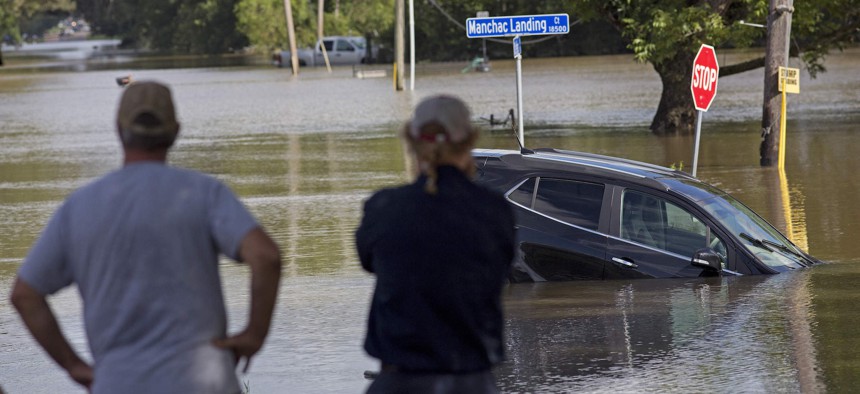When an Unnamed Storm Brings Far More Destruction Than a Named Hurricane

Residents survey the flood water on Old Jefferson Highway at Bayou Manchac in Prairieville, La., Tuesday, Aug. 16, 2016. AP File Photo / Max Becherer
Hurricane Nate will likely be quickly forgotten in Louisiana, but the impacts of last year’s catastrophic flooding are still being felt.
In the busy and destructive 2017 hurricane season, Hurricane Nate will likely end up as a relatively minor footnote compared to Harvey, Irma and Maria. The quickly moving storm didn’t have time to grow into a ferocious hurricane as it moved across the Gulf of Mexico and made landfall near the mouth of Mississippi River in Louisiana and again near Biloxi, Mississippi on Saturday as a minimal Category 1 system.
Reports from Louisiana, Mississippi and Alabama suggested only minimal damage and impacts as the storm weakened quickly and moved northward. Communities in Nate’s path were able to breathe a sigh of relief. It could have been worse.
While hurricanes with names like Katrina and Harvey will be long remembered and Nate will likely be forgotten, it doesn’t take a named storm system to be etched into the collective memory of a region.
Louisiana knows this all too well.
In August 2016, a slow-moving storm fueled by Gulf moisture dumped upwards of 20-30 inches of rain in and around Baton Rouge area, hitting East Baton Rouge, Ascension, Livingston and Tangipahoa parishes particularly hard. The unnamed storm killed 13 people and has been described as a 500-year or 1,000 year flood event. It also took the region largely by surprise and flooded between 50,000 to 75,000 structures including many not thought to be in a known flood zone.
The recovery from last year’s flooding has been slow-going, especially with housing.
As The Advocate reported on Saturday:
Of the roughly 4,300 households that temporarily relocated into trailers, some have secured permanent lodging—but roughly 63 percent have not: more than 1,500 in East Baton Rouge Parish, 900 in Livingston Parish and about 300 in Ascension Parish, according to [Federal Emergency Management Agency] figures.
The remaining families living in FEMA manufactured housing units following the August 2016 flooding have until February to move out.
Providing disaster housing assistance has been among the biggest disaster recovery challenges FEMA faces. During the National Emergency Management Association’s mid-year forum in March, Robert Fenton, a FEMA regional administrator who was serving as the agency’s interim chief at the time, noted that it was a tough challenge.
“We really need to focus on our disaster housing program,” Fenton said, making it “faster and more efficient.”
The 2017 hurricane season is certainly putting the agency to the test.
"The state of Texas is about to undergo one of the largest recovery-housing missions that the nation has ever seen," FEMA Administrator Brock Long said during a news conference following Hurricane Harvey in late August, as USA Today reported. “It’s a long process. Housing is going to be very frustrating in Texas. We have to set the expectations.”
Michael Grass is Executive Editor of Government Executive's Route Fifty and is based in Seattle.
NEXT STORY: New Mexico’s CIO on FirstNet: ‘The Pressure Is On Now’






